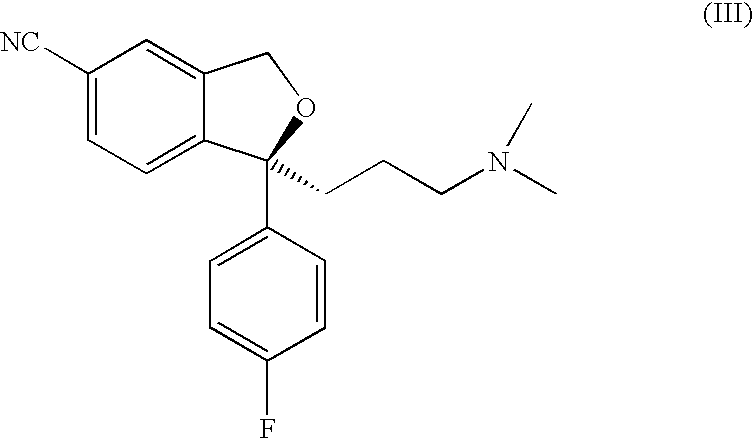Method for the preparation of escitalopram
a technology of escitalopram and escitalopram, which is applied in the field of preparation of the compound escitalopram, can solve the problems of not always being suitable for the purpose for chiral stationary phase, economic and environmental infeasibility of industrial production, and not always being economically feasible for industrial production
- Summary
- Abstract
- Description
- Claims
- Application Information
AI Technical Summary
Benefits of technology
Problems solved by technology
Method used
Image
Examples
example 2
Separation of 1-(4-bromo-2-hydroxymethyl-phenyl)-4-dimethylamino-1-(4-fluorophenyl)-butan-1-ol
A column with the dimensions 280×110 mm packed with ChiralPak® (20 μm particle size) was used as the chiral stationary phase. A mixture of 95% acetonitrile and 5% methanol was used as the mobile phase.
The operation conditions were as follows: Temperature: 29° C. Flow rate: 500 mL / min Detection: UV 280 nm
500 g of a crude citalopram product containing 89% racemate was separated on the column. The first eluting enantiomer with a retention time of 11.0 min was isolated from the eluent with an enantiomeric excess of 99.5% in 99% yield. The second eluting enantiomer with a retention time of 14.1 min was isolated from the eluent with an enantiomeric excess of 99.2% in 98% yield.
example 3
Separation of 1-(4′-fluorophenyl)-1-(3-dimethylaminopropyl)-5-bromophtalane into its enantiomers.
A column with the dimensions 280×110 mm packed with Chiralcel®OD (20 μm particle size) was used as the chiral stationary phase. A mixture of 98% vol isohexane and 2% vol isopropanol was used as the mobile phase.
The operation conditions were as follows: Temperature: Ambient temperature Flow rate: 500 mL / min Detection: UV 285 nm
500 g of a crude product containing 89% racemate was separated on the column. The first eluting enantiomer with a retention time of 5.4 min was isolated from the eluent with an enantiomeric excess of 99.5% in 96% yield. [α]D=−0.81° (c=0.99, MeOH); The second eluting enantiomer with a retention time of 6.7 min was isolated from the eluent with an enantiomeric excess of 99.4% in 99% yield. [α]D=+0.95° (c=1.26, MeOH);
example 4
Separation of 1-(4′-fluorophenyl)-1-(3-dimethylaminopropyl)-5-bromophtalane into its enantiomers using supercriticalfluid chromatography.
A column with the dimensions 250×10 mm packed with Chiralcel®OD (10 μm particle size) was used as the chiral stationary phase. As mobile phase was used carbon dioxide and modifier in a ratio of 90:10. The modifier was methanol with diethylamine (0.5%) and trifluoroacetic acid (0.5%).
The operation conditions were as follows: Temperature: Ambient temperature Flow rate: 18.9 mL / min Pressure: 20 kPa Detection: UV 254 nm
75 mg of racemic mixture was separated on the column.
Both enantiomers were isolated from the eluent. The enantiomers were isolated with an enatiomeric excess of 86.1% (RT 3.25 min) and 87.1% (RT 3.67 min), respectively.
PUM
 Login to View More
Login to View More Abstract
Description
Claims
Application Information
 Login to View More
Login to View More - R&D
- Intellectual Property
- Life Sciences
- Materials
- Tech Scout
- Unparalleled Data Quality
- Higher Quality Content
- 60% Fewer Hallucinations
Browse by: Latest US Patents, China's latest patents, Technical Efficacy Thesaurus, Application Domain, Technology Topic, Popular Technical Reports.
© 2025 PatSnap. All rights reserved.Legal|Privacy policy|Modern Slavery Act Transparency Statement|Sitemap|About US| Contact US: help@patsnap.com



